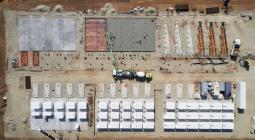Conceived in a dream, new solar canoe will serve Amazon tribes.
- A solar-powered canoe, just the second of its kind, is scheduled for launch around April 20 in the village of Sharamentsa on the Pastaza River in the Ecuadorean Amazon.
- The canoe is part of a project that aims to connect nine remote indigenous communities through an alternative transportation system powered by the sun and channeled by Amazon rivers.
- The launch coincides with the comeback of the first canoe, which has been grounded by technical problems, and the opening of a solar community center in Sharamentsa that will function as a canoe-recharging station and will eventually provide power to the village.
- Project leaders intend to build similar solar centers in other villages that, along with the canoes, will ultimately form a large energy and transportation network powered by sunlight.
A group of 20 men, women, and children, mostly members of the Achuar and Shuar indigenous communities, move through dense jungle near a military base in the town of Shell Mera in central Ecuador. It’s July 19, 2018, and the ground is muddy because of an earlier rain. They are pushing a 14-meter (46-foot) canoe with a roof covered in solar panels toward the banks of the Pastaza River.
A few hours earlier, the solar canoe had arrived on the base, part of the Achuar territory, after traveling 330 kilometers (205 miles) by truck from the town of Lago Agrio where it was built. After a kilometer of travel through the jungle, dodging branches and roots, the group arrives at the river. It’s time for the canoe’s inaugural voyage: a day-long trip of 90 kilometers (56 miles), including four hours over Class II rapids. Finally, it reaches serene waters adjacent to Sharamentsa village, its new home port.
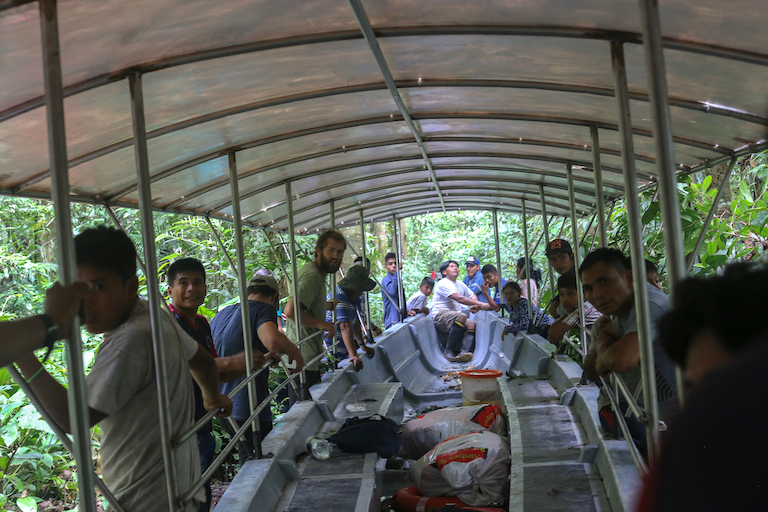
More than eight months since that inaugural voyage, the solar canoe is now ready to begin work. It’s the second of its kind, part of a project called Kara Solar. The project, still in the pilot stage, aims to connect nine remote Achuar communities through an alternative transportation system powered by the sun and channeled by Amazon rivers. The launch, scheduled for around April 20, coincides with the comeback of the first canoe, which technical problems grounded in recent months, and the opening of a solar community center in Sharamentsa. The center will function as a canoe-recharging station and will eventually provide power to the village, including a center for making various products from native plants and a hotel run by members of the community.
The two vessels are meant to help members of those communities move much more easily between villages. The best option currently is to take a plane: A public airline offers flights once or twice a week for about $15. But flights are regularly canceled when the plane isn’t full or the weather is bad, and the only alternatives are to hire a private flight that costs $200 per passenger or find someone with a motorized canoe willing to make the trip.
Opening roads through the pristine rainforest — in one of the most biodiverse places in the world — is not an option for the Achuar. And the price of gasoline to fuel motorboats, the main form of transportation, is higher than in other parts of Ecuador. The fuel arrives by small plane, quintupling the price. Solar energy was the logical alternative.
During the first canoe’s first three months in operation, it offered trips three or four times a week. The route took four to six hours, depending on weather conditions and the season. Rides have a symbolic cost of $1 per section between villages.
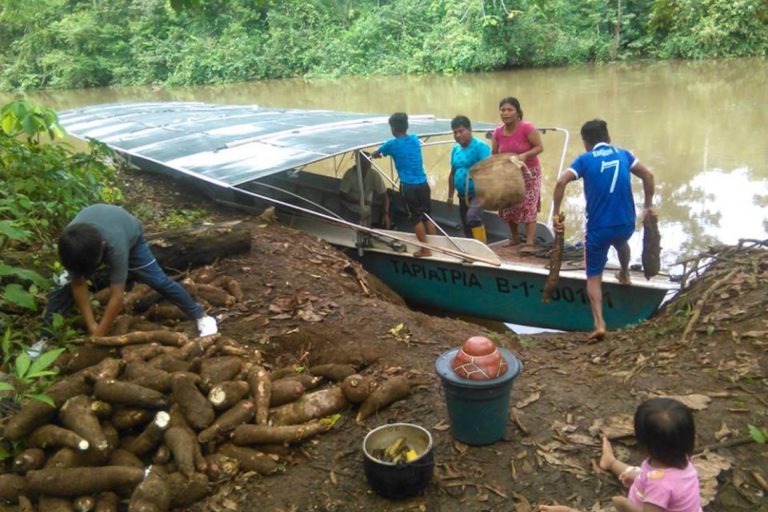
Behind the Kara Solar initiative are the Achuar Nationality of Ecuador (NAE by its Spanish initials), which represents all of the country’s Achuar, and the Ecuador-based Latin American Association for Alternative Development (ALDEA). Members of the Achuar community have been the project’s boosters and main protagonists since the beginning. “
They invited us to be their accomplices,” said Paola Maldonado, ALDEA’s president.
The Achuar have participated in every decision, from the design of the project to the choice of its name. In their language, also called Achuar, Kara means “a dream or vision that comes true.” The solar boat’s invention involved technological innovation, traditional boatbuilding methods and fantasy. According to Maldonado, as with other Amazonian groups, the world of dreams is part of the Achuar’s daily life and guides their plans for the future.
In Achuar communities, most decision-making happens during a special ceremony. At 4 a.m., men gather in a circle and drink a caffeinated herbal infusion called guayusa that induces vomiting. This purge, called a guayusada, is meant to fill their bodies with energy so they can interpret and discuss the dreams of the previous night.
Elderly and wise men who participated in this ritual several years ago reputedly glimpsed, in dreams, a “fire canoe” or a “canoe moved by the sun” arriving in their lands by river. The community also tells a tale about a man who disappeared suddenly, only to return some time later transformed into an electric fish in charge of transporting animals around the jungle. It is no coincidence that the name chosen for the first boat, Tapiatpia, means “electric fish” in Achuar. The community has yet to settle on a name for the new boat.
Now this vision, which has been part of the Achuar’s collective imagination for decades, is being realized. The transportation system will serve nine villages along 67 kilometers (42 miles) of the Capahuari and Pastaza Rivers. Some of the villages don’t have schools or hospitals, so cheaper and easier transportation between them was important for the Achuar. The group occupies territories in both Ecuador and Peru. But the project, in its initial phase, benefits only those nine communities on the Ecuadorian side, 1,200 people out of the nearly 7,800 Achuar living in the country.

The Achuar’s relationship with nature also plays a fundamental role in their society. They haven’t allowed oil or mining companies to enter their territories. Nor do they support the construction of highways through Amazonian forests, even if it would bring improved transportation. According to the international NGO World Wide Fund for Nature (WWF), 3 hectares (7.4 acres) of Amazon forest are felled every minute to build roads.
“There is always pressure from people in big cities to build new roads,” said Nantu Canelos, local coordinator of Kara Solar for the Achuar communities. “But we don’t see roads as a sign of development. Our environment is our blessing. That is why the solar boats are the perfect alternative for us.”
Canelos, an NAE representative, is the nexus between the Achuar communities and other people involved in the project. Although he joined the initiative only a year ago, he now participates in every meeting — in the form of guayusadas — convened to make decisions about the solar boats. When the first canoe was working, he used it several times, mainly to share news about the progress of the project with the villages.
Working with Canelos is Oliver Utne, the president and founder of Quito-based Kara Solar. He is a historian and environmentalist born in Minnesota. In his last year of college, in 2007, he visited Ecuador and fell in love with the Achuar culture. Years later, he returned to the region as a long-term volunteer. Aware of the needs of the communities he has lived in, Utne began talking with the leaders to try to find ways to improve their living conditions.
A slow, collective process backs the solar boats, he told Mongabay. It took them five years to come up with the idea. There was the vision of the fire canoe; then, they had to turn it into a reality.
For that, they needed technologists and engineers. Researchers with the Center for Ocean Engineering at the Massachusetts Institute of Technology and Escuela Superior Politécnica del Litoral in Guayaquil collaborated on navigation studies, examining the conditions and characteristics of 200 kilometers (124 miles) of Amazonian rivers.
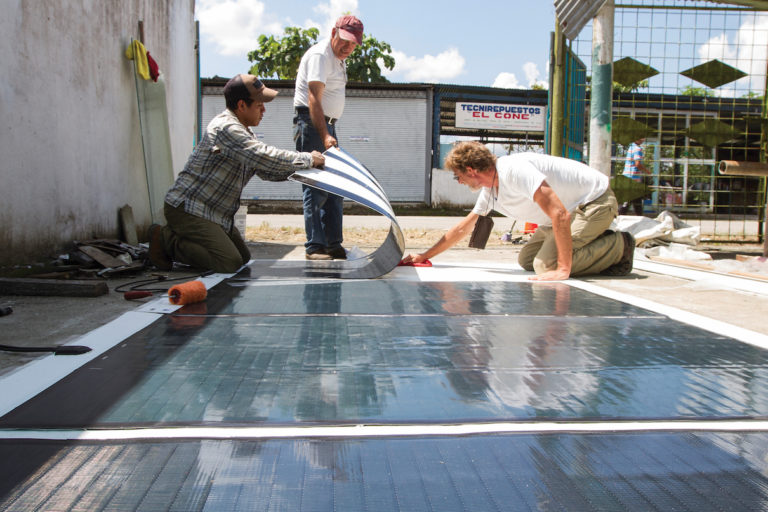
For the construction of the first boat, Tapiatpia, Kara Solar recruited Peter May, an electrical engineer from Munich who had spent more than 30 years working on solar energy projects in the Amazon. To design and build Tapiatpia, May and his team — Achuar included — traveled in late 2016 to the village of Dureno in Lago Agrio, the capital of Sucumbíos province in northeastern Ecuador. There they worked in a workshop run by another indigenous group, the Kofan, who are experts in building canoes to navigate Amazonian rivers. Assembling the canoe took the team a couple of months.
Tapiatpia’s inaugural voyage, 1,800 kilometers (1,118 miles) of river in a circuitous route from a village outside Lago Agrio to the Achuar territories, took 25 days. Two Achuar men, Hilario Saant and Mario Gualinga, assumed the roles of captain and motorist. Utne also joined the crew of eight. On April 22, 2017, they arrived in Sharamentsa.
Utne, who says the design of Tapiatpia reminds him of a spaceship, briefly described the first solar canoe’s technical characteristics. It is 16 meters (52.5 feet) long with a hull just over 2 meters (6.5 feet) deep. It’s made of fiberglass and stainless steel. To capture and store sunlight, 32 flexible solar panels cover the roof and charge batteries that last for seven hours. The boat can carry 20 people, including the captain and motorist, at a speed of 14 kilometers (8.7 miles) per hour.

They made a few changes to the second canoe. It’s smaller, for one. And they had to change the motor. For Tapiatpia, they used noiseless electric motors manufactured by a German company that proved unsuitable for the harsh conditions of Amazon rivers, so the first boat has been functioning only intermittently. During the two years it took to build the new boat, Kara Solar’s engineering team has been experimenting with new electric motors, and they are working on a prototype specially adapted to function in the Amazon.
Perhaps most important, though, issues with the solar panels prompted an expansion of the project. “The experience with the first boat taught us that the roof doesn’t have to store all the energy. It had worked fine in the prototype, but having so many panels on the roof made it complex,” Utne said. “So we settled on building recharging stations that power a micro-electrical network for the community.” Sharamentsa has the first solar station; other villages will follow. Utne and his team ultimately envision a large energy infrastructure powered by sunlight.
Despite the problems, the Achuar communities are confident the system will ultimately succeed. Canelos has experienced the benefits of the solar boat himself and heard the positive testimonies of others who have used it. Most value the ability to move from one village to another — to go to the hospital when they are sick, for example — in an easy and sustainable way. And students appreciate the possibility of returning home on weekends thanks to the solar boat.
“It represents the dream of the Achuar people,” Canelos said.
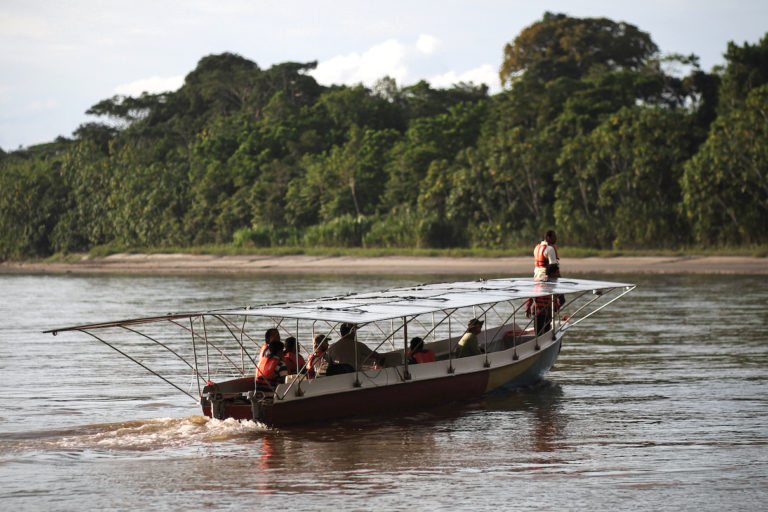
Gabriela Balarezo is a multimedia journalist based in Ecuador and Spain. Her main areas of interest are environmental issues, culture and social journalism. Follow her on Twitter: @gabibal.
3 April 2019


